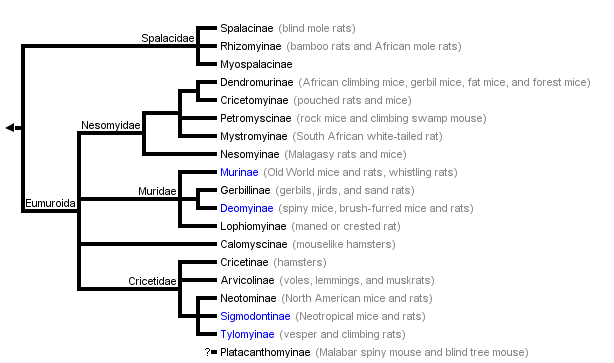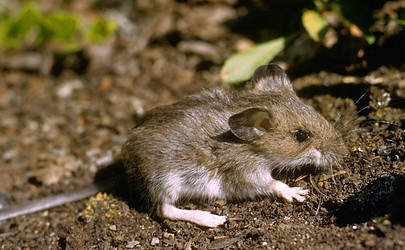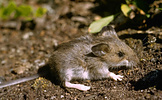Muroidea
Murid rodents
Scott J. Steppan


This tree diagram shows the relationships between several groups of organisms.
The root of the current tree connects the organisms featured in this tree to their containing group and the rest of the Tree of Life. The basal branching point in the tree represents the ancestor of the other groups in the tree. This ancestor diversified over time into several descendent subgroups, which are represented as internal nodes and terminal taxa to the right.

You can click on the root to travel down the Tree of Life all the way to the root of all Life, and you can click on the names of descendent subgroups to travel up the Tree of Life all the way to individual species.
For more information on ToL tree formatting, please see Interpreting the Tree or Classification. To learn more about phylogenetic trees, please visit our Phylogenetic Biology pages.
close boxIntroduction
Recent molecular studies using more slowly evolving nuclear genes have modified some traditional groupings based on morphology and greatly increased our confidence in most of the relationships. This muroid tree is based primarily on the nuclear DNA phylogenies of Steppan et al. (2004), Jansa and Weksler (2004), and Michaux et al. (2001) as well as Robinson et al. (1997) and Michaux and Catzeflis (2000). The classification used here follows Steppan et al. (2004) and differs from the more commonly used taxonomy of Musser and Carleton (1993) by recognizing more than a single family within Muroidea. Musser and Carleton (1993) chose to not subdivide the superfamily because of uncertainty about phylogenetic relationships among the many subfamilies. Strong concordance among many molecular phylogenies has greatly improved that situation.
References
Carleton, M. 1984. Introduction to rodents, pp. 255-265. In S. Anderson and J. K. Jones, Jr., eds., Orders and Families of Recent Mammals of the World. John Wiley and Sons, New York.
Carleton, M. D. 1980. Phylogenetic relationships on neotomine-peromyscine rodents (Muroidea) and a reappraisal of the dichotomy within New World Cricetinae. Miscellaneous Publications Museum of Zoology, University of Michigan, 157:1-146.
Carleton, M. D., and G. G. Musser. 1984. Muroid rodents, pp. 289-379. In S. Anderson and J. K. Jones, Jr., eds., Orders and Families of Recent Mammals of the World. John Wiley and Sons, New York.
Catzeflis, F. M., J. P. Aguilar, and J. J. Jaeger. 1992. Muroid Rodents - Phylogeny and Evolution. Trends Ecol. Evol., 7:122-126.
Catzeflis, F. M., A. W. Dickerman, J. Michaux, and J. A. W. Kirsch. 1993. DNA hybridization and rodent phylogeny, pp. 159-172. In F. S. Szalay, M. J. Novacek and M. C. McKenna, eds., Mammalian Phylogeny: Placentals. Springer-Verlag, New York.
Chaline, J., and J. D. Graf. 1988. Phylogeny of the Arvicolidae (Rodentia) - Biochemical and Paleontological Evidence. J. Mammal., 69:22-33.
Chevret, P., C. Denys, J. J. Jaeger, J. Michaux, and F. Catzeflis. 1993. Molecular and Paleontological Aspects of the Tempo and Mode of Evolution in Otomys (Otomyinae, Muridae, Mammalia). Biochem. Syst. Ecol., 21:123-131.
Dickerman, A. W. 1992. Molecular systematics of some New World muroid rodents. Ph.D. dissertation, University of Wisconsin-Madison.
Ellerman, J. R. 1941. The families and genera of living rodents. Vol. 2. Family Muridae. British Museum of Natural History, London, 690 pp.
Engel, S. R., K. M. Hogan, J. F. Taylor, and S. K. Davis. 1998. Molecular systematics and paleobiogeography of the South American sigmodontine rodents. Mol. Bio. Evol., 15:35-49.
Hooper, E. T., and G. G. Musser. 1964. The glans penis in neotropical cricetines (Muridae) with comments on classification of muroid rodents. Miscellaneous Publications, Museum of Zoology, University of Michigan, 123:1-57.
Jansa, S. A. and M. Weksler. 2004. Phylogeny of muroid rodents: relationships within and among major lineages as determined by IRBP gene sequences. Mol. Phylogenet. Evol. 31:256-276.
Lavocat, R. 1978. Rodentia and Lagomorpha, pp. 69-89. In V. J. Maglio and H. B. S. Cooke, eds., Evolution of African mammals. Harvard Univ. Press, Cambridge, MA.
Michaux, J., and F. Catzeflis. 2000. The bushlike radiation of muroid rodents is exemplified by the molecular phylogeny of the LCAT nuclear gene. Mol. Phyl. Evo. 17:280-293.
Michaux, J., A. Reyes, and F. Catzeflis. 2001. Evolutionary history of the most speciose mammals: molecular phylogeny of muroid rodents. Mol. Biol. Evol. 18:2017-2031.
Musser, G. M., and M. D. Carleton. 1993. Family Muridae, pp. 501-756. In D. E. Wilson and D. M. Reeder, eds., Mammal species of the world: a taxonomic and geographic reference. Smithsonian Institution, Washington.
Reig, O. A. 1980. A new fossil genus of South American cricetid rodents allied to Wiedomys, with an assessment of the Sigmodontinae. Journal of Zoology (London), 192:257-281.
Robinson, M., F. Catzeflis, J. Briolay, and D. Mouchiroud. 1997. Molecular phylogeny of rodents, with special emphasis on murids: Evidence from nuclear gene LCAT. Mol. Phylogenet. Evol. 8:423-434.
Smith, M. F., and J. L. Patton. 1999. Phylogenetic relationships and the radiation of sigmodontine rodents in South America: evidence from cytochrome b. J. Mamm. Evol., 6:89-128.
Steppan, S. J., R. M. Adkins, and J. Anderson. 2004. Phylogeny and divergence-date estimates of rapid radiations in muroid rodents based on multiple nuclear genes. Syst. Biol. 53:533-553.
Verheyen, E., M. Colyn, and W. Verheyen. 1995. The phylogeny of some African muroids (rodentia) based upon partial mitochondrial cytochrome b sequences. Belg. J. Zoolog., 125:403-406.
Verheyen, E., M. Colyn, and W. Verheyen. 1996. A mitochondrial cytochrome b phylogeny confirms the paraphyly of the Dendromurinae Alston, 1896 (Muridae, Rodentia). Mammalia, 60:780-785.
Information on the Internet
The Mouse Genome. Nature December 2002.Title Illustrations

| Scientific Name | Peromyscus maniculatus |
|---|---|
| Location | Teslin Lake (Alaska, USA) |
| Comments | Deer Mouse |
| Creator | Photograph by Glenn and Martha Vargas |
| Specimen Condition | Live Specimen |
| Source Collection | CalPhotos |
| Copyright |
© 2002 California Academy of Sciences

|
About This Page
Scott J. Steppan

Florida State University, Tallahassee, Florida, USA
Correspondence regarding this page should be directed to Scott J. Steppan at
Page copyright © 2001 Scott J. Steppan
All Rights Reserved.
Citing this page:
Steppan, Scott J. 2001. Muroidea. Murid rodents. Version 01 January 2001 (under construction). http://tolweb.org/Muroidea/16461/2001.01.01 in The Tree of Life Web Project, http://tolweb.org/







 Go to quick links
Go to quick search
Go to navigation for this section of the ToL site
Go to detailed links for the ToL site
Go to quick links
Go to quick search
Go to navigation for this section of the ToL site
Go to detailed links for the ToL site